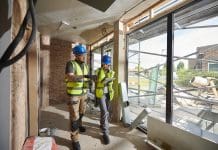Adopting new technology can be daunting but, argues Steve Mansour of CRL, the potential benefits for both builders and end users mean it is time to embrace connected construction
The Internet of Things (IoT) is not a new concept. In fact, it has been a discussion point for decades and the first smart appliance, a toaster, was actually connected to the internet back in 1989.
Property wise, many connected trends focus on inside the home – be it networked climate controls, security solutions or connected appliances. However, outside the home, the construction industry has been slow to adopt technology innovations.
Last year, the sector was found to be one of the least digitised industries. Alongside the fact that construction labour productivity has not kept pace with overall productivity, it seems the need to invest in technology to keep the industry running is a given. These tools are aimed at increasing efficiencies, reducing cost and ensuring, as much as possible, that projects run on time – so resistance to change seems nonsensical, particularly when this is one of the goals for large builders and developers.
While the construction industry isn’t necessarily known for its connection to technology, there are a surprising amount of tools that have arisen to help those within the sector, such as virtual reality (VR), including 3D building modelling. From 3D walkthroughs to sell a property to 3D VR modelling used to pitch architectural projects, there are numerous benefits to adopting this technology. In addition to the increased efficiencies and reduced costs, it can allow builders to stand out from the crowd when marketing their property to consumers and gain an edge on their competitors.
BIM
One such VR process that is widely used in construction is building information modelling (BIM). BIM is a process that provides a 3D model of a building, which can be used to model a building’s structure and systems during both design and construction. However, it doesn’t only provide a model; it also offers data management capabilities that can keep everyone on the project team on the same page at all stages of the build, from conception to construction documentation and maintenance.
AR
Augmented reality (AR) is at a much earlier stage in its adoption, partly due to health & safety concerns, the need for a large data repository and the complexity of tracking constantly moving data. However, the benefits of AR far outweigh the concerns and this is evident by the recent investment of £1m of funding into a consortium from Innovate UK. The investment is aimed at developing an Augmented Worker System (AWE), which will pioneer the use of virtual and augmented reality for the construction industry. With a focus on reducing cost and waste, and increasing productivity, the system will improve the construction process at every stage, delivering “faster builds to a higher quality with fewer defects and more sustainable buildings”.
With construction projects often plagued by problems, working off old school paper blueprints and drawings makes it harder to capture, analyse and share data with the different contractors involved in the process. But tools like these are reinventing the industry, with innovative ideas adding to it at every stage; for example, the smart helmet designed specifically for industrial settings from Daqri and the SmartReality app from JBKnowledge, which allows users to hold a smartphone or tablet over designs or plan files and see 2D drawings projected as 3D models.
Continued investment in the construction industry is imperative to ensure it has the capabilities to respond and react to developments and changes. Through programmes like the government’s in Digital Built Britain (DBB) and through the development of innovative new technology, planners and architects are given more opportunity to collaborate with contractors, while reassuring clients and addressing any concerns they may have.
In addition, developers need to be forward-thinking to attract talent with the skills to make use of these new technologies, and adopting these is sure to create increased interest from the digital generation. Embracing the Internet of Things will also allow builders and developers to push boundaries and drive the expectation and quality of new builds forward. These tools are already being used in large-scale commercial builds, so it is time that they become the norm for large residential builders and developers too.
The adoption of innovative ways of working can be daunting, but ultimately, builders and developers need to ensure they are keeping up with new and improved ways of working that will benefit the industry, as well as the end user. Since the creation of the first connected appliance, we have come a long way – but there is still a mountain to climb when looking at how this technology can, and will, benefit us in the very near future.
Steve Mansour
Chief Executive
CRL
Tel: +44 (0)808 273 2532
Twitter: @crlmanagement
Facebook: CRLManagementLimited
LinkedIn: CRL Management Limited














